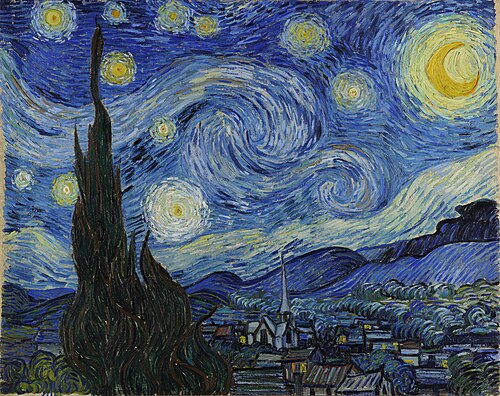
Vincent van Gogh’s The Starry Night, painted in 1889 during his stay at the Saint-Paul-de-Mausole asylum in Saint-Rémy-de-Provence, stands today as one of the most celebrated and emotionally resonant works in the history of Western art. Though created in a period of personal turmoil, the painting reveals a visionary synthesis of imagination, observation, and expression, reflecting van Gogh’s extraordinary ability to convey the complex interplay between emotion and the natural world.
What strikes viewers first is the swirling, energetic night sky—alive with motion and vibrant color. Van Gogh employed his signature impasto technique, applying thick layers of paint to create dynamic movement and texture. His use of bold blues and intense yellows creates both contrast and harmony, and the composition draws the eye through spiraling stars, a glowing crescent moon, and turbulent waves of wind that seem to ripple across the heavens. At the base of the sky lies a calm village, slumbering beneath the cosmic spectacle above. This juxtaposition between chaos and peace, celestial dynamism and terrestrial stillness, gives the painting its haunting power.
A tall, dark cypress tree stretches upward from the foreground, bridging the village and the sky. Often associated with death and eternity, the tree becomes a visual and symbolic anchor. Some scholars suggest that it represents van Gogh’s meditation on mortality—his personal longing to find meaning or perhaps escape in the infinite night. The church steeple among the village buildings is another point of intrigue. Though not part of the actual landscape visible from his window, van Gogh included it, likely drawn from memory or symbolism. It could signify his complex relationship with spirituality and his search for solace in something greater than himself.
Despite its imaginative nature, The Starry Night includes surprisingly accurate elements. Astronomers and historians have verified that the planet Venus appears in the sky at the correct place and time for when the painting was made. Yet van Gogh wasn’t aiming for scientific precision; he was capturing a feeling, a perception—a metaphysical truth that defied literal representation. This fusion of emotion and nature makes The Starry Night a singular achievement.
Modern science has added fascinating dimensions to the painting’s legacy. In the 21st century, physicists discovered that the swirling patterns in The Starry Night closely mirror fluid turbulence, a complex natural phenomenon described decades later by Kolmogorov’s theory of turbulence. The luminous whorls in the painting exhibit a statistical behavior matching turbulent flows, leading researchers to marvel at how van Gogh, without formal knowledge of physics, intuitively visualized a phenomenon that science only later understood. His work, therefore, not only speaks to the soul but also aligns uncannily with mathematical truths about the physical universe.
Despite his brilliance, van Gogh himself did not consider The Starry Night a successful painting. In letters to his brother Theo, he expressed ambivalence about its execution, viewing it as a failure in certain respects. This tragic disconnect between his inner critique and the painting’s later acclaim adds another layer of poignancy. That he could create something so transcendent while doubting its worth underscores the profound struggles he endured as an artist and as a person.
The Starry Night continues to resonate powerfully with audiences more than a century after it was painted. Housed at the Museum of Modern Art in New York City, it remains one of the most visited and studied artworks in the world. Its influence extends far beyond the canvas, echoing through pop culture, literature, music, and even science. It is not only a symbol of van Gogh’s genius but a mirror in which generations have found reflections of their own wonder, longing, despair, and hope.
Ultimately, The Starry Night is not merely a depiction of a night sky—it is an intimate portrait of the human condition. Through its swirling stars and contemplative stillness, it captures the tension between chaos and calm, between the known and the infinite. It stands as a testament to the power of art to transcend suffering, to reveal hidden harmonies, and to turn pain into beauty. In that sense, van Gogh gave the world more than a painting; he gave it a way to see, to feel, and perhaps to heal.
